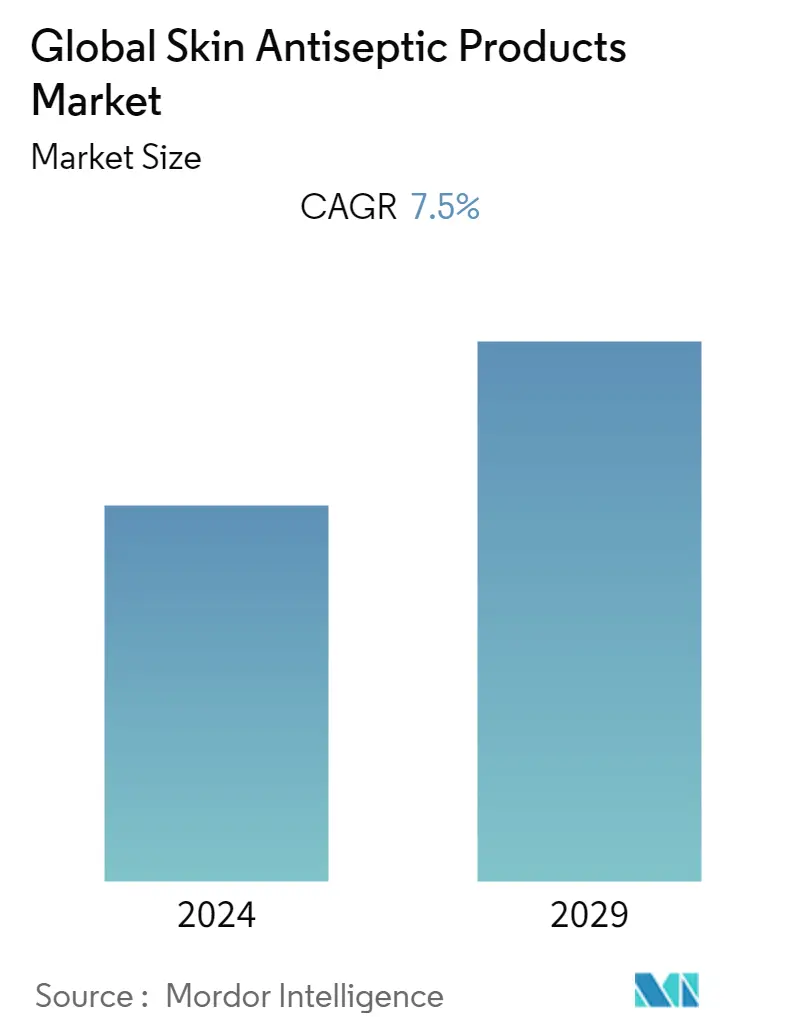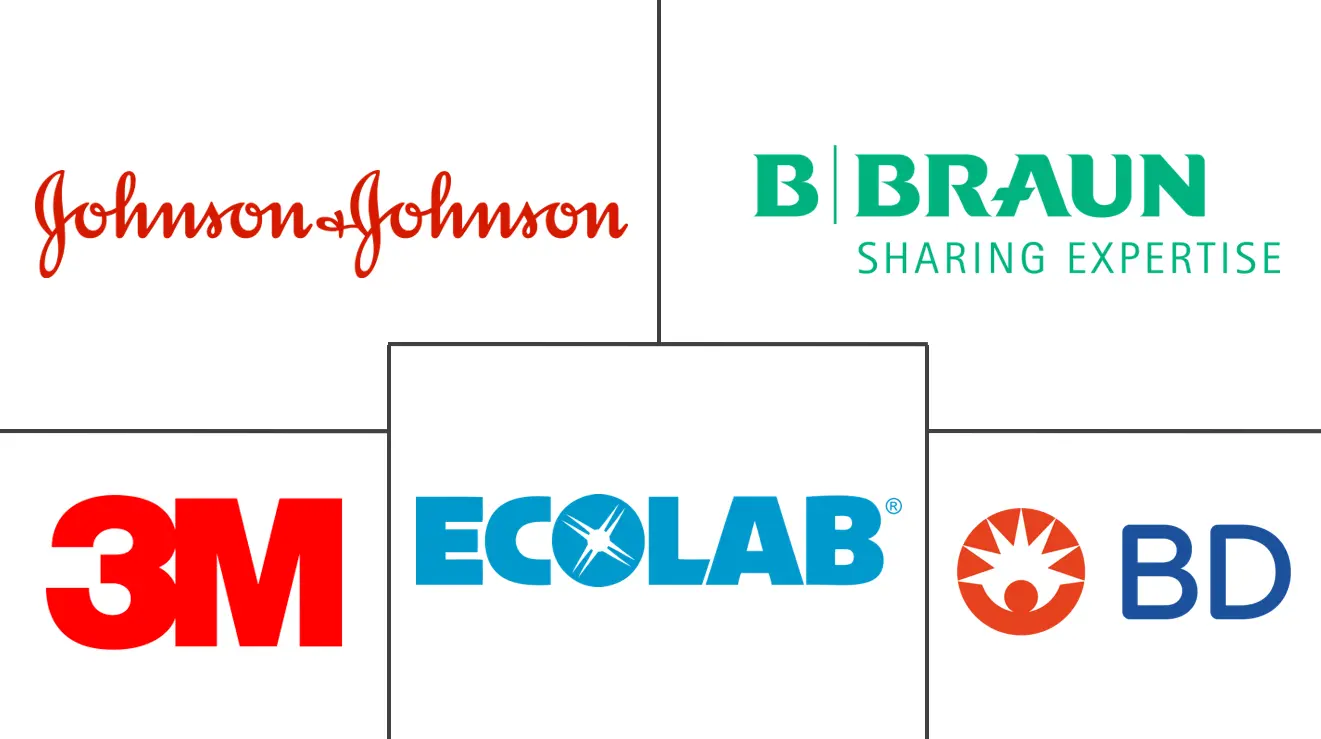Market Size of Global Skin Antiseptic Products Industry

| Study Period | 2019 - 2029 |
| Base Year For Estimation | 2023 |
| Forecast Data Period | 2024 - 2029 |
| CAGR | 7.50 % |
| Fastest Growing Market | Asia Pacific |
| Largest Market | North America |
Major Players
*Disclaimer: Major Players sorted in no particular order |
Skin Antiseptic Products Market Analysis
The skin antiseptic products market is projected to register a CAGR of 7.5% during the forecast period.
The healthcare system has witnessed enormous challenges as a result of the COVID-19 pandemic. All outpatient treatments were postponed or restricted during the COVID-19 pandemic to reduce the risk of viral transmission as most chronic therapies were regarded as non-urgent. However, with the advent of the COVID-19 infection, the necessity for antiseptic products has increased significantly, to restrict the spread of the infection. For instance, an article titled 'Oral Antiseptics Against Coronavirus: In-Vitro and Clinical Evidence' published in the Journal of Hospital Infection in July 2021 indicated that oral antiseptics can be used in the inactivating and eradicating the coronaviruses, thereby leading to a lower risk of transmission via salivary droplets or aerosols. The article suggested the use of oral antiseptics such as povidone-iodine, hydrogen peroxide, chlorhexidine, and cetylpyridinium chloride to reduce the intra-oral viral load in COVID-19-positive patients. The increasing use of antiseptics during the COVID-19 pandemic significantly added to the market growth.
The demand for these products is increasing, due to a higher prevalence of Hospital Acquired Infections (HAIs), lack of sanitation and precaution, and increased use of surgical units and endoscope reprocesses. Furthermore, the global antiseptic industry is witnessing a higher rate of growth, due to increased expenditure on healthcare, elevated incidences of hospital-acquired infectious diseases, and increased awareness of cleanliness and disinfection measures. Skin antiseptic is used to maintain human or non-living germ-free. With COVID-19, there has been an increase in awareness about bacterial, viral, and fungal infections and their prevention with the use of antiseptics. This is expected to have a positive impact on the market growth.
Also, the increase in nosocomial infections poses a serious challenge to health care professionals globally during the COVID-19 pandemic. In September 2021, a study published in the Infection Control and Hospital Epidemiology titled "The Impact of Coronavirus Disease 2019 (COVID-19) on Healthcare-Associated Infections in 2020: A Summary of Data Reported to The National Healthcare Safety Network" showed that there was a significant increase in the number of healthcare-associated infections (HAIs) in the year 2020 than the previous year. The rapid rise in HAIs is majorly attributed to the COVID-19 pandemic. Hospitals are found to boost their infection control protocols to avoid or destroy hospital-acquired infections for the patient and hospital staff's safety. Thus, there is an increasing demand for the skin antiseptics market to prevent the further spread of such hospital-acquired infections. These infections also present a significant economic burden at the societal level. However, a large percentage of HAIs are preventable through effective infection prevention and control measures. Thus, the increasing demand for the prevention of hospital-acquired infections is likely to add to the growth of the studied market during the forecast period.
Moreover, the recent antiseptic product launches by market players worldwide are adding to the market growth. For instance, in November 2021, Emami Limited launched the non-sticky antiseptic cream BoroPlus soft ayurvedic antiseptic cream in India. Also, in December 2021, MedLife Formulations Pvt. Ltd. launched Septicol antiseptic liquid, which is effective in killing or slowing down viruses, bacteria, and other harmful microorganisms. Such product launches are expected to significantly add to the growth of the studied market during the forecast period.
However, the side effects associated with the antiseptics and the risk of permeability are hindering the growth of the skin antiseptics market.
Skin Antiseptic Products Industry Segmentation
As per the scope of the report, skin antiseptics are used to protect against germs and remove existing microorganisms in their bodies. The process of managing infections is considered a crucial element that keeps people and non-living things free from germs. The skin antiseptic products market is segmented by formulation (alcohols, chlorhexidine, iodine, and other formulations), type (solutions, swab sticks, and wipes), application (surgeries, injection, and other applications), and geography (North America, Europe, Asia-Pacific, Middle East and Africa, and South America). The report offers the value (in USD million) for the above segments.
| By Formulation | |
| Alcohols | |
| Chlorhexidine | |
| Iodine | |
| Other Formulations |
| By Type | |
| Solutions | |
| Swab Sticks | |
| Wipes |
| By Application | |
| Surgeries | |
| Injection | |
| Other Applications |
| Geography | ||||||||
| ||||||||
| ||||||||
| ||||||||
| ||||||||
|
Global Skin Antiseptic Products Market Size Summary
The skin antiseptic products market is experiencing significant growth, driven by the increased demand for infection control measures, particularly in the wake of the COVID-19 pandemic. The pandemic highlighted the critical need for antiseptics to prevent the spread of viruses, leading to a surge in their usage. This heightened awareness of hygiene and infection prevention has been further fueled by the rising prevalence of hospital-acquired infections and the growing number of surgical procedures worldwide. The market is characterized by the introduction of innovative products by key players, which are contributing to its expansion. Despite the challenges posed by potential side effects and permeability issues, the market continues to thrive, with alcohol-based antiseptics leading the segment due to their effectiveness in pre-operative preparations and hand sanitization.
North America is poised to dominate the skin antiseptic products market, supported by a robust healthcare infrastructure and a high incidence of nosocomial infections. The United States, in particular, is a major contributor to this growth, driven by supportive healthcare policies and a developed market. The region's market expansion is further bolstered by strategic investments and product launches by leading companies. The competitive landscape is marked by the presence of several major players, including BD, 3M, Ecolab, and Johnson & Johnson, who are actively engaging in product development to meet the rising demand for effective infection control solutions. As the market continues to evolve, these factors are expected to sustain its growth trajectory over the forecast period.
Global Skin Antiseptic Products Market Size - Table of Contents
-
1. MARKET DYNAMICS
-
1.1 Market Overview
-
1.2 Market Drivers
-
1.2.1 Rising Prevalence of Hospital-acquired Infections
-
1.2.2 Increasing Number of Surgeries
-
-
1.3 Market Restraints
-
1.3.1 Side effects and risk of Permeability
-
-
1.4 Porter's Five Force Analysis
-
1.4.1 Threat of New Entrants
-
1.4.2 Bargaining Power of Buyers/Consumers
-
1.4.3 Bargaining Power of Suppliers
-
1.4.4 Threat of Substitute Products
-
1.4.5 Intensity of Competitive Rivalry
-
-
-
2. MARKET SEGMENTATION (Market Size by Value - in USD Millions)
-
2.1 By Formulation
-
2.1.1 Alcohols
-
2.1.2 Chlorhexidine
-
2.1.3 Iodine
-
2.1.4 Other Formulations
-
-
2.2 By Type
-
2.2.1 Solutions
-
2.2.2 Swab Sticks
-
2.2.3 Wipes
-
-
2.3 By Application
-
2.3.1 Surgeries
-
2.3.2 Injection
-
2.3.3 Other Applications
-
-
2.4 Geography
-
2.4.1 North America
-
2.4.1.1 United States
-
2.4.1.2 Canada
-
2.4.1.3 Mexico
-
-
2.4.2 Europe
-
2.4.2.1 Germany
-
2.4.2.2 United Kingdom
-
2.4.2.3 France
-
2.4.2.4 Italy
-
2.4.2.5 Spain
-
2.4.2.6 Rest of Europe
-
-
2.4.3 Asia-Pacific
-
2.4.3.1 China
-
2.4.3.2 Japan
-
2.4.3.3 India
-
2.4.3.4 Australia
-
2.4.3.5 South Korea
-
2.4.3.6 Rest of Asia-Pacific
-
-
2.4.4 Middle-East and Africa
-
2.4.4.1 GCC
-
2.4.4.2 South Africa
-
2.4.4.3 Rest of Middle-East and Africa
-
-
2.4.5 South America
-
2.4.5.1 Brazil
-
2.4.5.2 Argentina
-
2.4.5.3 Rest of South America
-
-
-
Global Skin Antiseptic Products Market Size FAQs
What is the current Global Skin Antiseptic Products Market size?
The Global Skin Antiseptic Products Market is projected to register a CAGR of 7.5% during the forecast period (2024-2029)
Who are the key players in Global Skin Antiseptic Products Market?
BD, B. BRAUN MELSUNGEN AG, Ecolab, 3M and Johnson & Johnson are the major companies operating in the Global Skin Antiseptic Products Market.

